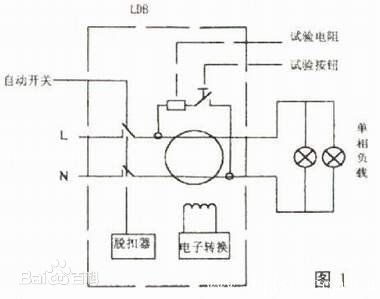The operation principle of the leakage protection switch is that there are two groups on an iron core: an input current winding and an output current winding. When there is no leakage, the input current and output current are equal, and the vector of the two flux on the iron core is zero, so it will not feel the electric potential on the third winding. Otherwise, the third winding will induce the voltage to form and amplify the actuator. Make the switch trip.
The leakage protection switch is added in front of the UPS. Although there is no leakage phenomenon in UPS, the flux vector formed by harmonics in the core and the magnetic hysteresis of the core can not be zero, so there is a similar phenomenon of leakage, which makes the leakage protector trip frequently.
The leakage line will pass through a O type magnetic ring at the same time as the zero line of the fire line as the primary part, and the secondary N output will be used to drive an electromagnetic mechanism. The electromagnetic mechanism will be tripped. The principle is that the current flowing into the live line and the zero line is equal to the outflow under normal circumstances, so the secondary voltage induced is zero. When there is a grounding resistance or a short circuit on the line or zero line, the current on the line and zero line will appear. Voltage difference, through secondary induction, when a certain difference to promote the electromagnetic mechanism off the main circuit.
Fig. 1 is the working principle of the earth leakage protector. When working normally, there is no leakage current passing through the leakage protector except for the working current in the circuit. At this time, the current flowing through the zero sequence mutual inductor (transformer) is equal, the direction is opposite, the sum is zero, the inductive flux in the core of the mutual inductor is also equal to zero, the two winding has no output, the automatic switch is kept in the connection state, and the leakage protector is in the positive position. Run frequently. When there is leakage or electric shock between the protected electrical apparatus and the line, there will be a grounding fault current, which makes the current flowing through the detected transformer not zero, and the magnetic flux appears in the core of the transformer. The secondary winding of the transformer generates the induced current, which is amplified and output, so that the action of the leakage tripper can drive the automatic switch to trip to achieve the purpose of leakage protection.
Leakage protectors can be divided into electronic and electromagnetic types according to different release modes: 1. Electromagnetic release type leakage protectors, with electromagnetic release as an intermediate mechanism, make the mechanism release and disconnect power supply when leakage current occurs. The disadvantage of this protector is high cost and complex manufacturing process. Advantages are: strong anti-interference and anti-impact ability of electromagnetic components (impact of overcurrent and overvoltage); no auxiliary power supply; zero voltage and leakage characteristics after phase breaking remain unchanged. (2) The electronic leakage protector takes transistor amplifier as the intermediate mechanism. When leakage occurs, it is amplified by amplifier and transmitted to relay. The relay controls the switch to disconnect the power supply. The advantages of the protector are: high sensitivity (up to 5mA); small setting error, simple fabrication process and low cost. The shortcomings are: the transistor has weak shock resistance and poor anti-environmental interference; it needs auxiliary working power supply (electronic amplifier usually needs a dozen volts of DC power supply), so that the leakage characteristics are affected by the fluctuation of working voltage; when the main circuit is out of phase, the protector will lose its protection function.



Hotline
0757-82800666 Webchat
Webchat
 Website
Website